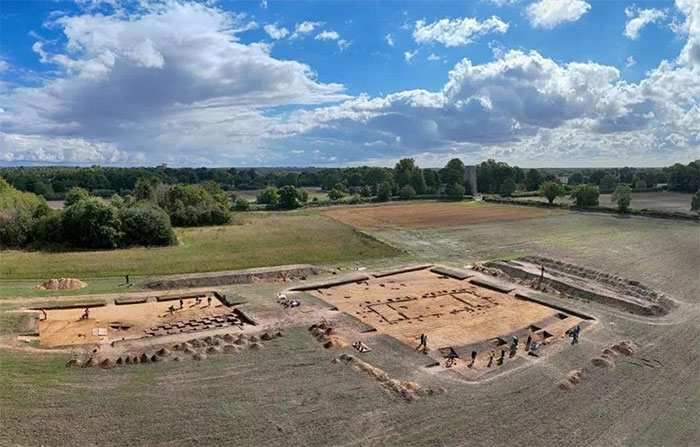A recent excavation has uncovered a complex hall in eastern England used by early Anglo-Saxon kings approximately 1,400 years ago to host feasts for their warriors and royalty.
The archaeological site at Rendlesham includes a royal complex dating back to the sixth and seventh centuries AD, which was built upon a larger Anglo-Saxon settlement established in the fifth century.
Archaeologists in eastern England have unearthed the remains of an elaborate hall where Anglo-Saxon kings and their warriors celebrated festivals around 1,400 years ago.

Newly discovered royal banquet area in England.
The remnants of the royal hall, located near the village of Rendlesham in Suffolk, approximately 110 km northeast of London, are just a few miles north of the famous Anglo-Saxon burial site at Sutton Hoo and several miles south of another burial site.
Archaeologists believe that both the Sutton Hoo and Snape burial sites belonged to rulers who resided at Rendlesham during their reigns, which spanned from 570 to 720 AD.
Faye Minter, a senior archaeological officer for Suffolk County Council, stated: “These are the burial sites of kings in Rendlesham over a period of about 150 years.”
Minter is currently leading the largest excavation of the royal complex at this site, which spans approximately 6 hectares. The foundations indicate that it was a wooden building around 23 meters long and 10 meters wide. It is likely that there were up to 10 halls within the royal estate for the king and his hundreds of attendants, but only the largest hall has been confirmed by the latest excavations.
This summer’s excavations revealed the foundations of a large wooden hall within the royal complex, where Anglo-Saxon kings and their warriors engaged in daily activities and dining.
The Anglo-Saxon Settlement
The royal residence at Rendlesham was part of a larger settlement established in the fifth century AD, shortly after the beginning of the Anglo-Saxon invasion of England around 450 AD.
Minter added: “The overall settlement covers about 50 hectares, but from the late sixth century, there was a defined area [of the royal complex] within the larger settlement. Thus, they placed the royal residence within an already significant Anglo-Saxon settlement.
The royal residence is recorded in the works of the eighth-century English scholar Bede, who identified it as the site where, in 662 AD, King Aethelwald of East Anglia sponsored the baptism of King Swithelm of the East Saxons (a kingdom near London also known as Essex). At this time, Swithelm was an adult, and the baptism represented the kingdom’s conversion from paganism to Christianity; Aethelwald’s dynasty had been Christian for several decades.
This royal banquet hall was first identified through aerial imagery (satellite images) in 2015, but it was during this summer’s excavation that it was revealed as trenches uncovered fragments of glass drinking vessels and ceramics; personal items like bronze pins; an iron knife; and remnants of food preparation and feasting. These artifacts suggest that a significant amount of beef and pork was consumed there—a luxury at a time when the Anglo-Saxons primarily relied on vegetables.
Archaeologists suggest that the halls within the royal complex were used for several months, after which the king and his entourage would move to another royal residence.


















































